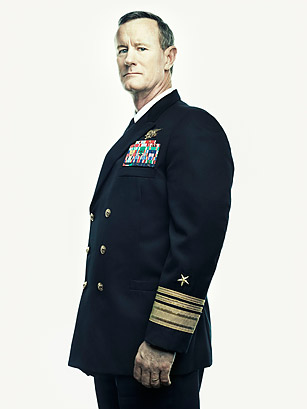
William McRaven was tumbling from the sky, and there wasn't much sky left.
It was July 18, 2001, midway through that quiet summer before the whole world learned Osama bin Laden's name. McRaven, then a 45-year-old Navy SEAL captain, led a jump exercise near San Diego.
The commandos dropped into 10,000 feet of free fall, reserving their parachutes for the last moment. As they neared the release point, one of the men below McRaven drifted directly underneath. Seconds later, his canopy slammed into McRaven at well over 100 m.p.h., throwing him into a violent spin.
"Frankly, I wasn't sure whether I had been knocked unconscious, so when I had the chance, I pulled my rip cord," McRaven told TIME. "Part of the chute wrapped around one leg, the risers around the other, and the good news is that it opened. The bad news is that when it opened, it split me like a nutcracker, I guess, and just kind of broke the pelvis, broke my back."
Eight weeks later came the surprise attacks of Sept. 11. McRaven and his four SEAL teams had trained for such a moment, but it was all he could do to follow the news in bed. Naval Special Warfare Group 1 began the hunt for Osama bin Laden without its commodore, and he soon stepped down from command.
The story did not end there. McRaven recovered and rose up the ranks. Bin Laden lay low and stayed alive. This year, a decade later, their paths finally crossed.
By the time U.S. intelligence pinpointed its quarry, McRaven was a three-star admiral atop the Joint Special Operations Command (JSOC), the U.S. military's clandestine strike force. And so on Jan. 29, it was McRaven who began to plan "finish options" for bin Laden alongside his counterparts in a seventh-floor CIA conference room. On May 1, with President Obama's go-ahead, it was McRaven who commanded the helicopter assault against the al-Qaeda leader's redoubt in Abbottabad, Pakistan. And on that night it was McRaven, linked by secure video from Jalalabad to the White House, who briefed the President in real time as the operation progressed.
"He was almost like the voice of Walter Cronkite, completely calm," says Michael Leiter, who was present as director of the National Counterterrorism Center.
When the lead helicopter lost its lift and crash-landed in an animal pen, one participant in the video call said he thought he might vomit.
"As you see, we have a helicopter down," McRaven said, expressionless.
Then: "We're going to push the QRF," the quick-reaction force.
Then, as commandos set explosive charges around the wounded aircraft: "We're going to destroy the helicopter."
Toward the end, with the assault team moving from room to room, McRaven stepped unexpectedly away from the screen. An unnerving silence descended as the camera stayed on the admiral's empty chair, his habitual yellow can of Rip It energy drink in the foreground. Then McRaven swung back into the picture. "I want to confirm we have a call of 'Geronimo EKIA,' " he said evenly.
Just like that, it was over. Bin Laden was in American hands, status adjusted: "enemy killed in action." Leon Panetta, who joined the video call from CIA headquarters, told TIME's Massimo Calabresi that "all the air we were holding came out." In his Kabul headquarters as outgoing U.S. commander in Afghanistan, General David Petraeus pumped his fist. "There was a degree of coming to closure," he says.
Operation Neptune Spear stripped al-Qaeda of its iconic leader and offered a kind of recompense for the traumas of 9/11. Billions of dollars and the labor of countless men and women had led to that day. Patient and ingenious work by U.S. intelligence agencies marked a spot — tentative, but more likely accurate than not — on the map. The Commander in Chief staked his presidency on a military plan with risks that daunted his Secretary of Defense.
Still, there was something more elemental in the final transaction. A small group of men would fly nearly 200 miles through the dark, and then they would kill, or fail to kill, a mortal foe. On that mission, they were representing a tribe that had trained and bled and hungered for 31 years to redeem itself as sensationally as it had failed in its public debut.
In a new book from TIME, Special Ops: The Hidden World of America's Toughest Warriors, international editor Jim Frederick reports on the secret world of the U.S. military units. Now available in bookstores everywhere, or go to time.com/specialops to order your copy today.